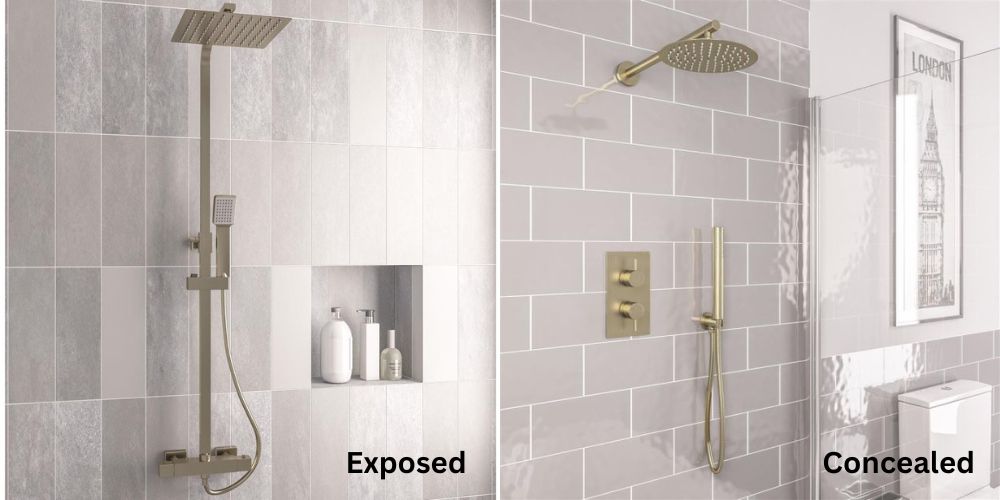What is a shower valve?
A shower valve is like the control centre of your shower, it's the part of the shower you use to control both temperature and flow. It's the most important part of the shower set up and below are examples of what the valve part of the shower might look like.
This guide will attempt to sift through the jargon and help you make an informed decision on what to look for and which type of valve best suits your installation.
We have tried to break this up into several manageable chunks but of course feel free to ring/email or live chat our friendly team who will guide you through the process of choosing the valve that's best for you.
Exposed shower valves vs Concealed shower valves

This is perhaps best demonstrated with the use of an image.
With an exposed shower valve both the outlets and pipes are visible in the bathroom. You only need to run the hot and cold pipes behind the tiles up to the valve.
However, with a concealed shower valve only the controls (handles) are visible. This means the pipes and outlets are hidden behind your tiles. The concealed shower valve is becoming increasingly popular due to it's minimalist and modern look.
Thermostatic vs Manual
A very important consideration when choosing your shower is whether to go Manual or Thermostatic. It's essential therefore to understand the difference.
With a manual valve, the temperature handle simply adjusts the amount of hot and cold water that comes through the valve, the temperature itself is not actually controlled in any way. There is a danger with this type of valve, that if someone turns another water source on in another part of the house that the water flow into the valve is changed and the temperature can change dramatically.
This can lead to severe scolding if you are actually stood in the shower when this happens.
It is therefore recommended that this type of shower is only used to control shower heads that are not going to be used to shower under, for example shower heads used for cleaning etc.
Thermostatic showers contain a special thermostatic cartridge that dynamically adjusts the hot and cold waterflow to maintain the set temperature.
For example if you set the valve to be 38o degrees, the valve will adjust the amount of hot and cold input to automatically achieve this temperature. If someone turns on a cold tap somewhere else in the house, then the valve will automatically adjust the amount of hot water to account for the drop in cold input in order to maintain the required 38o degrees.
Outlets vs Handles

This is a common question we get asked and is the source for most of the confusion we get when purchasing valves. The confusion is limited to concealed valves and some examples of these are shown in the images above to try and help understand.
Handles simply refers to the number of physical handles on the shower valve.
Outlets refers to the number of things the shower is actually controlling.
For example, a 2 outlet shower might control an overhead shower and a handheld shower and a 3 outlet shower might be an overhead shower, body jets and a bath spout.
There isn't a different valve depending on WHAT those outlets are, but it is a different valve depending on how MANY outlets there are.
The number of handles dictate the way in which those outlets are operated. On most concealed showers one of the handles controls the temperature, the other handle(s) operate the outlet(s), with the more the handle is turned the more flow is achieved.
To give you an idea of some of the configurations that exist on popular showers :-
2 outlets - 3 handles
- Top handle - operates outlet 1
- Middle handle - controls the temperatures
- Bottom handle - operates outlet 2
2 outlets - 2 handles
- Top handle - turn left for outlet 1 and turn right for outlet 2
- Bottom handle - controls the temperature
Click the button below to check out our range of shower valves...
[related_products]